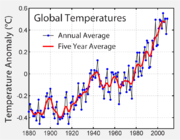
Mitigation of global warming involves taking actions to reduce greenhouse gas emissions and to enhance sinks aimed at reducing the extent of global warming. This is in distinction to adaptation to global warming which involves taking action to minimize the effects of global warming. Mitigation is effective at avoiding warming, but not at rapidly reversing it. Scientific consensus on global warming, together with the precautionary principle and the fear of abrupt climate change is leading to increased effort to develop new technologies and sciences and carefully manage others in an attempt to mitigate global warming.
The Stern Review identifies several ways of mitigating climate change. These include reducing demand for emissions-intensive goods and services, increasing efficiency gains, increasing use and development of low-carbon technologies, and reducing non-fossil fuel emissions.

The energy policy of the European Union has set a target of limiting the global temperature rise to 2 °C 3.6 °F compared to preindustrial levels, of which 0.8 °C has already taken place and another 0.5 °C is already committed. The 2 °C rise is typically associated in climate models with a carbon dioxide concentration of 400-500 ppm by volume; the current level as of January 2007 is 383 ppm by volume, and rising at 2 ppm annually. Hence, to avoid a very likely breach of the 2 °C target, CO2 levels would have to be stabilised very soon; this is generally regarded as unlikely, based on current programs in place to date. The importance of change is illustrated by the fact that world economic energy efficiency is presently improving at only half the rate of world economic growth.
At the core of most proposals is the reduction of greenhouse gas emissions through reducing energy use and switching to cleaner energy sources. Frequently discussed energy conservation methods include increasing the fuel efficiency of vehicles (often through hybrid, plug-in hybrid, and electric cars and improving conventional automobiles), individual-lifestyle changes and changing business practices. Newly developed technologies and currently available technologies including renewable energy (such as solar power, tidal and ocean energy, geothermal power, and wind power) and more controversially nuclear power and the use of carbon sinks, carbon credits, and taxation are aimed more precisely at countering continued greenhouse gas emissions. More radical proposals which may be grouped with mitigation include geoengineering techniques ranging from carbon sequestration projects such as carbon dioxide air capture, to solar radiation management schemes such as the creation of stratospheric sulfur aerosols. The ever-increasing global population and the planned growth of national GDPs based on current technologies are counter-productive to most of these proposals.
From http://en.wikipedia.org/
Tidak ada komentar:
Posting Komentar
Catatan: Hanya anggota dari blog ini yang dapat mengirim komentar.